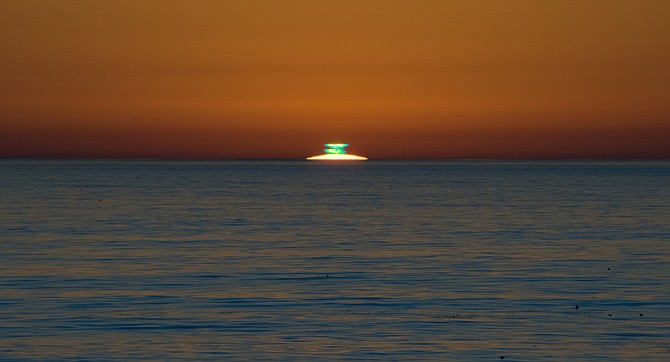 Facebook
Facebook
 X
X
 Instagram
Instagram
 TikTok
TikTok
 Youtube
Youtube

The Crescent Moon returns to evening sky on Thursday, January 14. Look for its thin, smiling shape low in the southwestern sky about 30 minutes after the sun sets. On the following day (Friday) the slightly thicker crescent moon will be much easier to spot, and it will be visible for a longer period of time after sunset.
The Fabled “Green Flash” at sunset or sunrise can sometimes be seen on crystal-clear days in January. At the instant the sun’s upper rim is last visible at sunset, and also at the instant when it is first seen at sunrise, a flash of emerald-green color may be observed, especially on a flat horizon. Physicists explain this peculiar phenomenon as due to color-dispersion (as in a prism) and scattering of sunlight through the Earth’s atmosphere. Binoculars (or a small telescope) are helpful in spotting it. For green-flash hunting at sunset, any site with a view of the ocean horizon suffices. For the sunrise green flash, any spot overlooking the low desert (Sunrise Highway in the Laguna Mountains, for example) is good.
Above Orion shines orange Aldebaran with the large, loose Hyades cluster in its background. Binoculars are the ideal instrument for the Hyades given the group's size: its brightest stars (4th and 5th magnitude) span about 4°. (The Pleiades higher above are hardly more than 1° across counting just the brightest stars.)
The main Hyades stars famously form a V. It's currently lying on its side, and Aldebaran forms the lower left tip of the V. With binoculars, follow the lower branch of the V to the right from Aldebaran. The first thing you come to is the House asterism: a pattern of stars like a child's drawing of a house with a peaked roof. The house is currently upright and bent to the right like it got pushed.
The above comes from the Outdoors listings in the Reader compiled by Jerry Schad, author of Afoot & Afield in San Diego County. Schad died in 2011. Planet information from SkyandTelescope.org.


The Crescent Moon returns to evening sky on Thursday, January 14. Look for its thin, smiling shape low in the southwestern sky about 30 minutes after the sun sets. On the following day (Friday) the slightly thicker crescent moon will be much easier to spot, and it will be visible for a longer period of time after sunset.
The Fabled “Green Flash” at sunset or sunrise can sometimes be seen on crystal-clear days in January. At the instant the sun’s upper rim is last visible at sunset, and also at the instant when it is first seen at sunrise, a flash of emerald-green color may be observed, especially on a flat horizon. Physicists explain this peculiar phenomenon as due to color-dispersion (as in a prism) and scattering of sunlight through the Earth’s atmosphere. Binoculars (or a small telescope) are helpful in spotting it. For green-flash hunting at sunset, any site with a view of the ocean horizon suffices. For the sunrise green flash, any spot overlooking the low desert (Sunrise Highway in the Laguna Mountains, for example) is good.
Above Orion shines orange Aldebaran with the large, loose Hyades cluster in its background. Binoculars are the ideal instrument for the Hyades given the group's size: its brightest stars (4th and 5th magnitude) span about 4°. (The Pleiades higher above are hardly more than 1° across counting just the brightest stars.)
The main Hyades stars famously form a V. It's currently lying on its side, and Aldebaran forms the lower left tip of the V. With binoculars, follow the lower branch of the V to the right from Aldebaran. The first thing you come to is the House asterism: a pattern of stars like a child's drawing of a house with a peaked roof. The house is currently upright and bent to the right like it got pushed.
The above comes from the Outdoors listings in the Reader compiled by Jerry Schad, author of Afoot & Afield in San Diego County. Schad died in 2011. Planet information from SkyandTelescope.org.
Comments